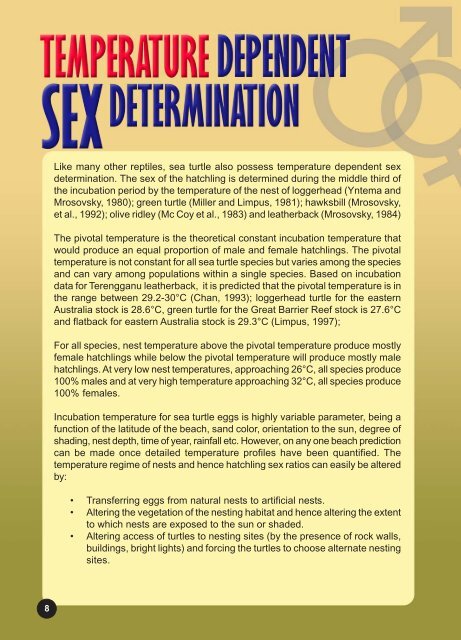Sea Turtle Hatchery - seafdec.org.my
Sea Turtle Hatchery - seafdec.org.my
Sea Turtle Hatchery - seafdec.org.my
Create successful ePaper yourself
Turn your PDF publications into a flip-book with our unique Google optimized e-Paper software.
Like many other reptiles, sea turtle also possess temperature dependent sex<br />
determination. The sex of the hatchling is determined during the middle third of<br />
the incubation period by the temperature of the nest of loggerhead (Yntema and<br />
Mrosovsky, 1980); green turtle (Miller and Limpus, 1981); hawksbill (Mrosovsky,<br />
et al., 1992); olive ridley (Mc Coy et al., 1983) and leatherback (Mrosovsky, 1984)<br />
The pivotal temperature is the theoretical constant incubation temperature that<br />
would produce an equal proportion of male and female hatchlings. The pivotal<br />
temperature is not constant for all sea turtle species but varies among the species<br />
and can vary among populations within a single species. Based on incubation<br />
data for Terengganu leatherback, it is predicted that the pivotal temperature is in<br />
the range between 29.2-30°C (Chan, 1993); loggerhead turtle for the eastern<br />
Australia stock is 28.6°C, green turtle for the Great Barrier Reef stock is 27.6°C<br />
and flatback for eastern Australia stock is 29.3°C (Limpus, 1997);<br />
For all species, nest temperature above the pivotal temperature produce mostly<br />
female hatchlings while below the pivotal temperature will produce mostly male<br />
hatchlings. At very low nest temperatures, approaching 26°C, all species produce<br />
100% males and at very high temperature approaching 32°C, all species produce<br />
100% females.<br />
Incubation temperature for sea turtle eggs is highly variable parameter, being a<br />
function of the latitude of the beach, sand color, orientation to the sun, degree of<br />
shading, nest depth, time of year, rainfall etc. However, on any one beach prediction<br />
can be made once detailed temperature profiles have been quantified. The<br />
temperature regime of nests and hence hatchling sex ratios can easily be altered<br />
by:<br />
• Transferring eggs from natural nests to artificial nests.<br />
• Altering the vegetation of the nesting habitat and hence altering the extent<br />
to which nests are exposed to the sun or shaded.<br />
• Altering access of turtles to nesting sites (by the presence of rock walls,<br />
buildings, bright lights) and forcing the turtles to choose alternate nesting<br />
sites.<br />
8

















